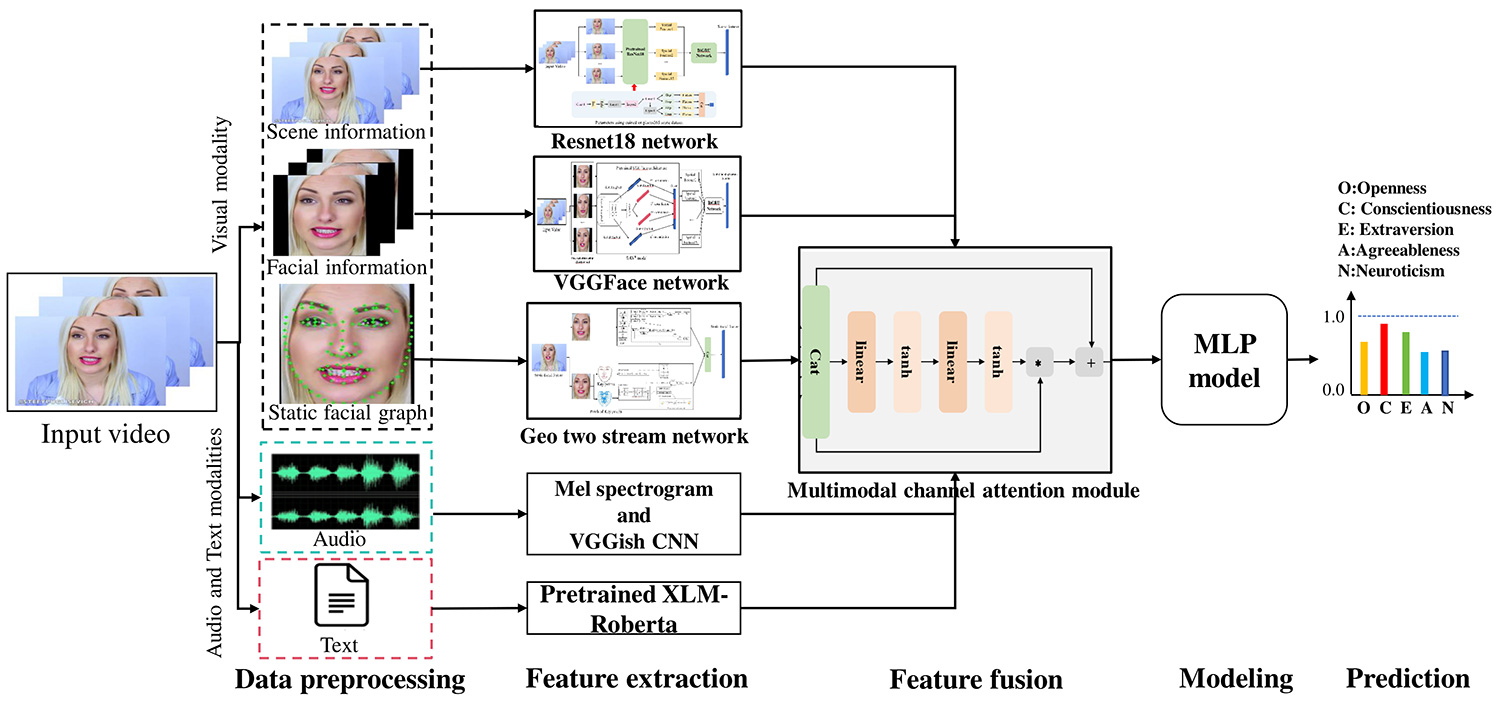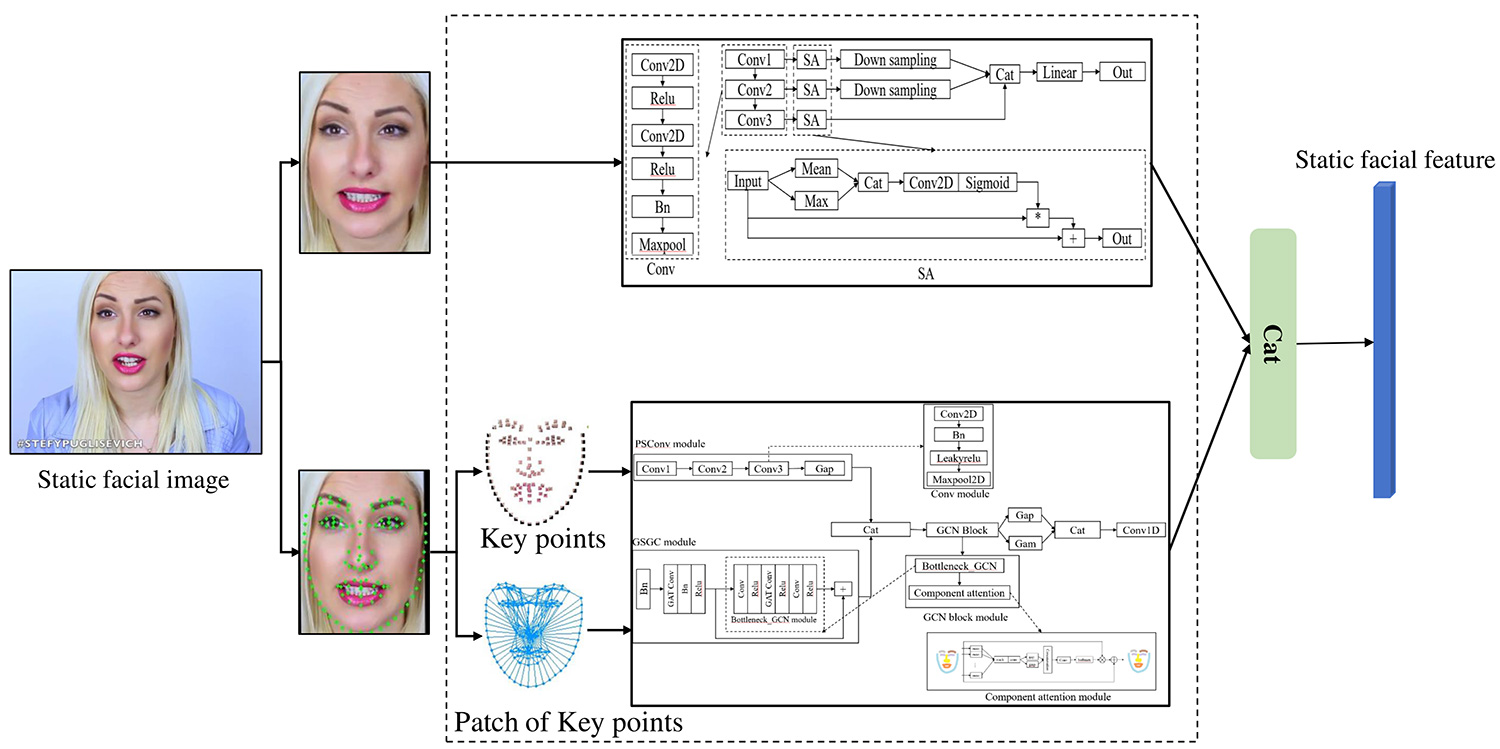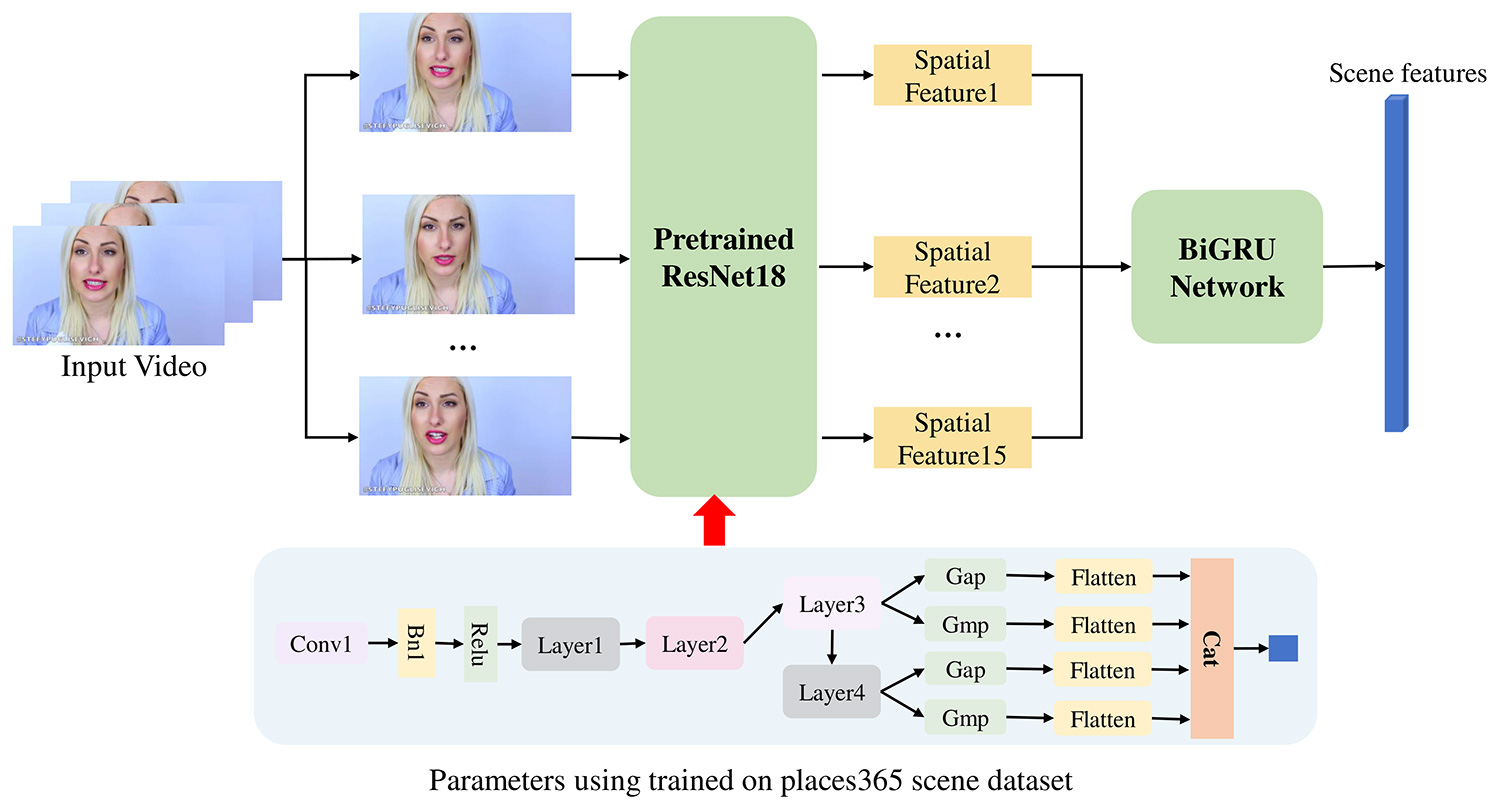IECE Transactions on Emerging Topics in Artificial Intelligence
ISSN: 3066-1676 (Online) | ISSN: 3066-1668 (Print)
Email: [email protected]


In recent years, the study of personality analysis has gained significant interest across various fields, including computer vision, linguistics, and related disciplines [1]. Over the past few decades, researchers have developed different personality trait models based on psychological scales, with the Big Five model being one of the most widely recognized. This model evaluates personality through five key dimensions: Openness (O), Conscientiousness (C), Extraversion (E), Agreeableness (A), and Neuroticism (N). Personality traits play a crucial role in shaping individuals' decision-making processes and preferences, making personality prediction valuable for real-world applications such as job interviews [2], consumer behavior analysis, and beyond.
Leveraging multimodal features enhances the reliability of personality prediction by utilizing the complementary nature of different information sources. As a result, integrating multiple modalities has become a prominent approach in studying the Big Five personality traits. For example, Güçlütürk et al. [3] developed a deep residual network that effectively combines multiple modalities for personality trait recognition. Additionally, research has highlighted the predictive significance of facial features [1]. In particular, Ventura et al. [4] analyzed the role of specific Action Units (AUs) in facial feature assessment. To explore multimodal fusion, Subramaniam et al. [5] introduced two bi-modal end-to-end deep learning frameworks incorporating temporally structured audio and stochastic visual features. Furthermore, Kaya et al. [2] adapted a pre-trained Deep Convolutional Neural Network (DCNN) using an emotion change dataset to refine facial feature extraction. More recently, studies have investigated the link between visual contexts in short videos and personality traits. For instance, Suman et al. [6] utilized MTCNN and ResNet to derive facial and environmental attributes from visual inputs, while VGGish and an n-gram CNN model were employed for analyzing audio and text features. Similarly, Escalante et al. [7] proposed a multimodal deep learning approach incorporating audio, visual, and textual information for personality trait recognition [8, 9]. Despite these advances, most existing methods predominantly rely on CNN-based architectures, overlooking the potential of graph neural networks with visual attention to capture facial geometric structures. Moreover, while current models show promise in personality prediction, their accuracy still requires further enhancement.
To advance multimodal feature exploration and improve personality prediction accuracy, this paper presents a novel framework, MFLF-GSL (Multimodal Feature Learning Framework with Graph Structure Learning), designed for apparent personality analysis. This approach integrates visual, audio, and textual modalities to enhance predictive performance. For visual analysis, we propose a Geo two-stream method that captures both facial appearance and geometric attributes using a combination of Graph Convolutional Networks (GCN) and Convolutional Neural Networks (CNN) models with an attention mechanism. This method aims to model interactions between facial structure and appearance while emphasizing key facial regions relevant to personality traits. Specifically, GCN is responsible for extracting critical geometric relationships based on facial regions, whereas CNN captures local appearance-based features. Additionally, ResNet18 and VGGFace networks are utilized to derive spatial global facial appearance features from single images, contributing to personality inference. To capture temporal dependencies, a BiGRU network with a temporal attention module is employed to identify salient frame-level features over time.
To fully harness the complementary nature of multimodal data and enhance robustness, Log-Mel Spectrogram and VGGish CNN [10] are used for audio feature extraction, while the pre-trained XLM-RoBERTa [11] model is leveraged for text embeddings. Finally, a multimodal channel attention mechanism is introduced to integrate these features into a fused representation, which serves as input for an MLP model to predict the Big Five personality traits. The effectiveness of MFLF-GSL was validated through experiments on the ChaLearn First Impression-V2 dataset, demonstrating the proposed framework's ability to improve personality prediction performance.
The main contributions are summarized as follows:
We introduce a multimodal feature learning framework that incorporates a graph structure learning network with an attention mechanism to extract spatial-temporal features for personality trait prediction.
We develop an effective facial graph representation to extract both facial appearance and geometric features from static images. Additionally, we propose a novel graph structure learning network that captures personality-related representations by leveraging facial topology.
A multimodal channel attention module is designed to efficiently integrate features from multiple modalities. Furthermore, we introduce a temporal attention block module to emphasize crucial frame-level features in sequential data.
Extensive experiments are conducted to validate the proposed framework, demonstrating its effectiveness in personality trait prediction.
As depicted in Figure 1, our framework takes a short video of an individual as input and predicts their personality traits. It consists of four key stages: data preprocessing, feature extraction using modality-specific networks, feature fusion, and final regression via an MLP model. During data preprocessing, the input video is segmented into distinct streams corresponding to multi-focus visual input, audio, and text. For feature extraction, separate modality-specific networks are employed to learn personality-related features, which are subsequently integrated using a multimodal channel attention module. Finally, the fused feature representation is used to predict personality trait scores.

Data Pre-processing: In the preprocessing stage for the visual modality, the video data is first converted into an image sequence. A self-trained UltraFace model is then applied to detect and extract facial images. Additionally, the PFLD face keypoint detector is used to identify 113 facial keypoints.
Model Architecture: This paper introduces three primary visual feature extraction methods: local static facial appearance features, facial geometric features, and scene appearance features.
Local Facial Appearance and Geometric Features Based on CNN and GCN Models: We introduce a Geo two-stream network that leverages CNN and GCN models to extract both facial appearance and geometric features from static facial images, as depicted in Figure 2.

The Geo network comprises two parallel streams: one dedicated to facial appearance and the other to facial geometry. The facial appearance image is fed into a static facial appearance CNN stream, which extracts local facial appearance features. This stream consists of three convolutional modules, enhanced by an attention mechanism (SA module), which helps the CNN model focus on salient facial regions associated with personality traits.
The facial geometric GCN stream integrates both CNN and GCN models. The CNN model processes local image patches around facial keypoints to extract localized appearance features, while the GCN model is responsible for capturing geometric structural features based on keypoint relationships. Specifically, the GCN module operates on a graph representation, denoted as ,
where represents the relative coordinate sets of keypoints, and defines the edge connections. The formulation is as follows:
where is the node feature matrix at layer , is the adjacency matrix, is the degree matrix, is the trainable weight matrix, and represents the activation function.
Here, represents the geometric feature representation of the facial keypoints, which is the output of . Specifically, denotes that each keypoint is represented by a feature of dimension after being processed by the GCN module, where corresponds to the total number of facial keypoints, set as . The same notation is consistently used in the following sections.
To enrich node features in the GCN stream, local appearance information from keypoints is incorporated as a supplementary descriptor. Specifically, for each keypoint in the static facial image, a local image patch is extracted, forming a set of local images:
where and denote the height and width of each local patch, both set to 48.
To integrate local appearance features into the GCN stream, this paper employs independent CNN modules, each dedicated to extracting localized features around a specific keypoint. These CNN modules share the same architecture but operate independently without parameter sharing. The local appearance representation extraction process is formulated as:
where denotes the feature representation of the -th local image, with a channel dimension of . The function represents the mapping function of the -th CNN module, which extracts local appearance features to construct a comprehensive representation of the local image , formulated as:
Finally, the extracted local appearance features and geometric features corresponding to the detected keypoints are concatenated to form a unified representation, denoted as
This representation encapsulates the structural features of the facial image, where the overall feature dimension is .
Global spatial-temporal scene feature based on Resnet18: To enhance the extraction of spatial-temporal scene features in short videos, as depicted in Figure 3, we utilize the ResNet18 model pre-trained on the Place365 dataset to directly derive scene features from individual video frames. Specifically, each frame is processed sequentially through the pre-trained ResNet18, generating a series of spatial-temporal scene representations. These extracted features are then passed through a BiGRU integrated with a temporal attention-block module, as shown in Figure 4, which selectively emphasizes key temporal scene frames.

Global facial appearance feature based on VGGFace: The study employs VGGFace [12] as a feature extractor to process each frame of facial images. Given that VGGFace is originally developed for facial recognition, it may not be directly suited for predicting the Big Five personality traits. To address this, the model undergoes fine-tuning using facial data from the Big Five dataset. Once optimal fine-tuned parameters are obtained, they are integrated into the VGGFace feature extraction process. Features from individual frames are then extracted using the DAN+ method. Finally, temporal dynamics are captured by leveraging a BiGRU with a temporal attention block, as shown in Figure 4, enabling the extraction of global facial appearance features from video sequences.

Data Pre-processing: The audio signal is converted into a Log-Mel Spectrogram representation. This transformation is carried out using Python's resample and soundfile libraries, which handle audio data input and output. Variations in speech patterns and intonation can serve as indicators of an individual's Big Five personality traits.
Model Architecture: In this study, we utilize the pre-trained VGGish CNN [10] as the audio feature extractor. The VGGish model processes each audio clip, approximately seconds in length, to generate 128-dimensional feature vectors that capture high-level semantics and meaning. For a video lasting around 15 seconds, this results in a feature matrix of size [25128]. To capture the temporal dynamics, we employ a BiGRU to extract the final audio features.
Data Pre-processing: To process the text and break it down into semantically meaningful units, this model splits the text into binary characters. These characters are then mapped to a predefined dictionary, producing an index sequence that represents the foundational features of the sentence. This sequence serves as the input for subsequent feature extraction.
Model Architecture: The pre-trained XLM-Roberta model [11] is used to extract text features, comprising 12 hidden layers and 12 self-attention heads, which produce an output of 768-dimensional feature vectors.
In this paper, we introduce a multimodal channel attention module. The five extracted feature vectors are first concatenated into a single feature vector, which is then fed into the module. The module evaluates the contribution of each branch and reduces information redundancy caused by the diversity of features. To prevent information loss, a residual structure is integrated into the module. As illustrated in Figure 5, the module includes two fully connected layers that compute the attention weight for each dimension in the multimodal representation . The attention weight can be calculated as follows:
where , , and represent the weight matrices and bias of the two fully connected layers, respectively. is used to confine the attention weight within the interval , and then the obtained attention vector to perform element multiplication with each dimension of the multimodal vector . The formula is as follows:
where is the output of the module, which is fed into MLP to predict the five major personality traits.

In this paper, a three-layer perceptron (MLP) is employed as the model for Big Five personality prediction. The activation of the first two linear layers uses the ReLU activation function, with a dropout layer added following each activation to prevent overfitting. The final layer employs a sigmoid activation function to ensure the predicted output is within the range of [0, 1].
We jointly optimize the entire framework using a multi-task loss function, which can be defined as follows:
where is the RMSE loss, is log-Cosh loss, and is the Bell Loss.
Implementation details: Our experiments are performed on a system equipped with an NVIDIA GeForce RTX 3090 GPU, utilizing PyTorch for model training. For the optimization process, the Geo two-stream network is trained using Stochastic Gradient Descent (SGD), while the other modalities are optimized with the Adam optimizer. The Geo two-stream network starts with an initial learning rate of 0.1, whereas the remaining models are initialized with a learning rate of 0.0001. Both weight decay and momentum parameters are set to 0.0001 and the default value.
| Model | Optimizer | Learning Rate | Batch Size |
|---|---|---|---|
| Geo Two-Stream | SGD | 0.1 | 32 |
| Facial Stream | Adam | 1e-4 | 32 |
| Audio/Text Module | Adam | 1e-4 | 32 |
| Scene Branch (ResNet18) | Adam | 1e-4 | 32 |
| Methods | Modalities | Open. | Cons. | Extr. | Agre. | Neur. | ACC(mean) |
|---|---|---|---|---|---|---|---|
| Wei et al. [1] | Visual and audio | 0.9120 | 0.9170 | 0.9130 | 0.9130 | 0.9100 | 0.9130 |
| Kaya et al. [2] | Visual and audio | 0.9169 | 0.9166 | 0.9206 | 0.9161 | 0.9149 | 0.9170 |
| Güçlütürk et al. [3] | Visual, audio and text | 0.9110 | 0.9150 | 0.9110 | 0.9110 | 0.9100 | 0.9116 |
| Bekhouche et al. [13] | Visual | 0.9138 | 0.9166 | 0.9175 | 0.9166 | 0.9130 | 0.9155 |
| Subramaniam et al. [5] | Visual and audio | 0.9131 | 0.9136 | 0.9145 | 0.9157 | 0.9098 | 0.9133 |
| Gurpınar et al. [14] | Visual and audio | 0.9140 | 0.9140 | 0.9190 | 0.9140 | 0.9120 | 0.9150 |
| Suman et al. [6] | Visual, audio and text | - | - | - | - | - | 0.9146 |
| Our method | Visual, audio and text | 0.9179 | 0.9215 | 0.9191 | 0.9187 | 0.9152 | 0.9185 |
| Methods | Modalities | Open. | Cons. | Extr. | Agre. | Neur. | ACC(mean) |
|---|---|---|---|---|---|---|---|
| Güçlütürk et al. [15] | Visual and audio | 0.9110 | 0.9140 | 0.9110 | 0.9100 | 0.9090 | 0.9110 |
| Subramaniam et al. [5] | Visual and audio | 0.9117 | 0.9119 | 0.9150 | 0.9119 | 0.9099 | 0.9121 |
| Wei et al. [1] | Visual and audio | 0.9120 | 0.9170 | 0.9130 | 0.9130 | 0.9100 | 0.9130 |
| Kaya et al. [2] | Visual and audio | 0.9170 | 0.9198 | 0.9213 | 0.9137 | 0.9146 | 0.9173 |
| Zhang et al. [16] | Visual and audio | 0.9123 | 0.9166 | 0.9133 | 0.9126 | 0.9100 | 0.9130 |
| Güçlütürk et al. [3] | Audio, visual, text | 0.9111 | 0.9152 | 0.9112 | 0.9112 | 0.9104 | 0.9118 |
| Bekhouche et al. [13] | Visual | 0.9101 | 0.9138 | 0.9155 | 0.9103 | 0.9083 | 0.9116 |
| Ventura et al. [4] | Visual and audio | 0.9100 | 0.9140 | 0.9150 | 0.9120 | 0.9070 | 0.9116 |
| Vo et al. [17] | Visual, audio and text | 0.8864 | 0.8772 | 0.8816 | 0.8958 | 0.8814 | 0.8845 |
| Principi et al. [18] | Visual and audio | 0.9167 | 0.9224 | 0.9159 | 0.9149 | 0.9134 | 0.9167 |
| Escalante et al. [7] | Visual, audio and text | - | - | - | - | - | 0.9161 |
| Suman et al. [6] | Visual, audio and text | 0.9111 | 0.9192 | 0.9173 | 0.9132 | 0.9103 | 0.9143 |
| Zhao et al. [19] | Visual, audio and text | - | - | - | - | - | 0.9167 |
| Our method | Visual, audio and text | 0.9169 | 0.9206 | 0.9189 | 0.9139 | 0.9136 | 0.9168 |
Dataset analysis: The CFI dataset annotations exhibit certain imbalances in the distribution of personality trait scores. For example, traits such as Agreeableness and Conscientiousness are skewed toward higher values, while others like Neuroticism show a more uniform distribution. To mitigate potential biases during training, all trait scores are normalized using z-score normalization. Moreover, we adopt regression-based evaluation metrics to reflect the continuous nature of the ground truth, and ensure that the training, validation, and test splits maintain similar statistical distributions across all five traits.
Datasets and evaluation criteria: To evaluate the performance of the proposed approach, we use the ChaLearn First Impression-V2 (CFI) dataset [20], which is publicly available and focuses on personality and interview prediction. The dataset is split into three subsets: the training set consisting of 6,000 videos, the validation set with 2,000 videos, and the test set, also containing 2,000 videos. Notably, the dataset's 10,000 videos are annotated with continuous ground-truth values by workers on Amazon Mechanical Turk.
For evaluation, the mean accuracy is used as the main quantitative metric across all the Big Five personality traits.
In the above equation, is the ground truth for the th sample and th trait, and is the predicted value for that sample. represents the total number of data samples present in the dataset.
Hyperparameter tuning: Key hyperparameters, such as learning rate, batch size, and weight decay, were tuned using grid search based on the validation set performance. For the Geo two-stream network, we tested learning rates in {0.01, 0.05, 0.1}, and selected 0.1 as it yielded the best convergence. Other models used Adam optimizer with learning rates tested in {1e-5, 5e-5, 1e-4}, where 1e-4 was found optimal. Batch size was fixed to 32 for all models to balance performance and memory consumption. A summary of key hyperparameter settings is provided in Table 1.
In this section, we compare the proposed framework with other advanced methods. Tables 2 and 3 display the performance comparison of the proposed framework with state-of-the-art methods on the CFI dataset for the validation and testing sets, respectively. From the experimental results, it can be seen that our framework achieved average Big Five personality prediction accuracy of 91.85 and 91.68 on the validation and test sets, respectively, which is significantly better than other excellent comparison methods.
Given that not all modal features contribute positively to predicting the Big Five personality traits, we introduce the Channel Attention Feature Fusion Module (Channel Attn). As shown in Table 4, our Channel Attn outperforms other fusion approaches, highlighting its ability to effectively assign weights to each modality, prioritize crucial modal features, and seamlessly integrate diverse modal information.
Table 5 shows a comparison of the performance with and without the proposed temporal attention block module. The findings demonstrate that integrating the temporal attention block improves our framework's performance, highlighting the importance of key temporal frames.
| Dataset | Fusion Type | Method | ACC(mean) |
|---|---|---|---|
| CFI | Early | Concatenation | 0.9180 |
| Modality Attn | 0.9180 | ||
| TFN fusion | 0.9182 | ||
| AMBF Attn | 0.9151 | ||
| Channel Attn (us) | 0.9185 | ||
| Hybrid | CentralNet | 0.9162 |
| Temporal attention block module | ACC(mean) |
|---|---|
| - | 0.9178 |
| 0.9185 |
| Method | Architecture Type | Accuracy (%) |
|---|---|---|
| Shared CNN Modules | Shared weights across patches | 89.47 |
| Independent CNN Modules (Ours) | Separate weights for each patch | 91.85 |
To extract discriminative local appearance features from facial regions centered around keypoints, we adopt independent CNN modules, each specialized for a specific facial patch. While these modules share the same architecture, they do not share parameters. This design is motivated by the observation that different facial regions (e.g., eyes, mouth, nose) exhibit distinct texture patterns and contribute unevenly to personality perception. Parameter sharing across patches could lead to underfitting and diluted region-specific representations, thereby limiting the model's ability to capture subtle variations critical for apparent personality analysis.
Although this design introduces increased computational cost compared to a shared-weight architecture, the modules are lightweight and operate on small local patches, thus keeping the overall resource usage manageable. Moreover, this independence allows the network to learn patch-specific filters, enabling finer-grained attention to personality-relevant micro-expressions. As shown in Table 6, replacing independent modules with a shared-weight variant results in a performance drop, which highlights the benefit of region-specific learning.
In this paper, we introduce a novel multi-modal feature learning framework aimed at predicting apparent personality traits. Our approach is built around a graph structure learning network enhanced with an attention mechanism, which uses learned static facial geometric features to boost performance. The framework begins by utilizing pre-trained models to extract features from multiple modalities, including visual global scene appearance, global facial appearance, audio, and text. These features are then further enriched with Bi-GRU/LSTM layers, incorporating a temporal attention block to capture crucial time-dependent information. The integrated features are processed through a multimodal channel attention module, which feeds into an MLP regression model to produce the final prediction. We conduct comprehensive evaluations on the CFI dataset, demonstrating that our framework achieves strong performance.
While the proposed graph-driven multimodal framework demonstrates strong performance in apparent personality assessment, several promising directions remain open for exploration. First, we plan to investigate more efficient graph construction strategies, such as dynamic or self-evolving graphs, to better capture interpersonal variability and contextual cues. Second, incorporating large-scale pretraining for multimodal alignment (e.g., cross-modal contrastive learning) could further enhance generalization to diverse domains. Moreover, extending the framework to multi-language scenarios and real-world deployment, such as real-time feedback in virtual interviews or social robots, represents a valuable avenue for practical impact. Finally, a deeper analysis of the interpretability and fairness of the learned personality representations will be an important step toward responsible AI applications in personality computing.
 Copyright © 2025 by the Author(s). Published by Institute of Emerging and Computer Engineers. This article is an open access article distributed under the terms and conditions of the Creative Commons Attribution (CC BY) license (https://creativecommons.org/licenses/by/4.0/), which permits use, sharing, adaptation, distribution and reproduction in any medium or format, as long as you give appropriate credit to the original author(s) and the source, provide a link to the Creative Commons licence, and indicate if changes were made.
Copyright © 2025 by the Author(s). Published by Institute of Emerging and Computer Engineers. This article is an open access article distributed under the terms and conditions of the Creative Commons Attribution (CC BY) license (https://creativecommons.org/licenses/by/4.0/), which permits use, sharing, adaptation, distribution and reproduction in any medium or format, as long as you give appropriate credit to the original author(s) and the source, provide a link to the Creative Commons licence, and indicate if changes were made. IECE Transactions on Emerging Topics in Artificial Intelligence
ISSN: 3066-1676 (Online) | ISSN: 3066-1668 (Print)
Email: [email protected]

Portico
All published articles are preserved here permanently:
https://www.portico.org/publishers/iece/